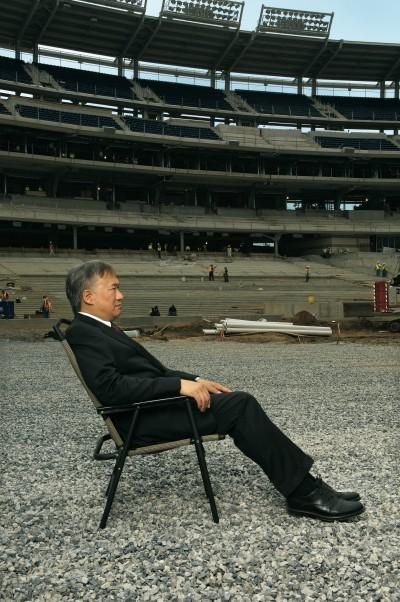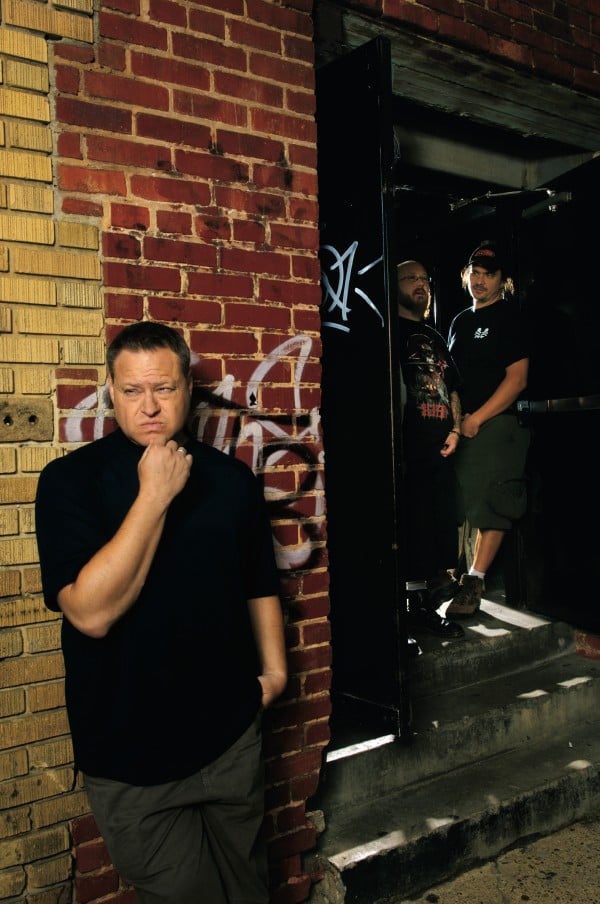Man Behind The Music
At the local record store where he worked growing up, Seth Hurwitz befriended kids with cars to get rides to concerts. At 14, he skipped school to buy tickets to the Rolling Stones and Stevie Wonder at RFK Stadium.
The thrill of a live show still drives Hurwitz, who owns DC’s 9:30 Club. But his focus has shifted. “Now I go to watch the audience more than the band,” he says.
Drawing on Washington’s rich history of indie-music venues and its sophisticated audiences, Hurwitz, 49, has turned 9:30 into a mecca for touring bands, a place that’s as packed for gypsy death-metal act Gogol Bordello as it is for Bob Dylan.
“Bands feel appreciated here,” Hurwitz says.
Because of 9:30’s success, other venues have called on Hurwitz and his production company, I.M.P., for booking and promotion, which means his eclectic tastes help decide what you’ll see on local stages. This summer at Merriweather Post Pavilion, he brought in acts ranging from bluegrass queen Alison Krauss to shock rocker Marilyn Manson.
“I’ve always been attracted to the alternative, the irreverent,” he says. “I can tell in five minutes whether or not a band’s for real.”
The Hurwitz-produced Virgin Festival in Baltimore, which featured the Police and the Smashing Pumpkins this year, is becoming one of the East Coast’s most popular music events.
Still, Hurwitz doesn’t take himself too seriously. “Let’s get real here,” he says. “It’s just a rock concert.”
—Drew Bratcher
Snow Job
Mike Lunsford, head of transportation for Loudoun County schools, got his bus license as a teenager at Loudoun County High when the coaches hired him to drive teams to games.
Once, to get traction during an ice storm, he drove 35 miles on the shoulder. Back then, if he got stuck in snow, Lunsford sent two of the strongest kids on the bus for help while he started digging.
Now he’s the one who makes the call on whether the county’s 53,000 kids get to stay home from school. At 3:30 am, two hours before the first buses go out, he hits the roads in his pickup truck to survey conditions. He checks video cameras monitoring school parking lots and reviews reports from Accuweather, whose services the county pays for.
“It might be raining near Dulles, snowing like the dickens in Leesburg, and icing somewhere else,” he says.
At home, Lunsford’s kids, ages 11 and 13, make their own evaluation. “After their snow dance, they’ll say it’s three inches deep when it’s only a dusting,” he says. “And then their friends start calling.”
—Drew Bratcher

Farmers' Best Friends
Ten years ago, when Bernie Prince and Ann Yonkers started a farmers market at DC’s Dupont Circle selling locally grown food, customers balked at the prices.
“We said, ‘Come down and taste it,’ ” Prince remembers. “You find stuff you won’t see elsewhere, like six or seven varieties of white peaches and nectarines.”
Slowly the two women won converts. They opened a second market in St. Michaels and started a nonprofit, FreshFarm Markets, that’s the invisible hand behind the two originals plus others in Foggy Bottom, Penn Quarter, H Street near Union Station, and Silver Spring.
“They’re like new town centers,” Prince says. “People like to see their neighbors and talk to the farmers.”
In 2006, the group grossed $3.4 million, up by 35 percent from the previous year—evidence, Yonkers says, of a trend: “I see it as the second revolution—the first one being the culinary revolution. This is going back to the roots of paying attention to where your food comes from. Instead of the quality of cooking, it’s the quality of the ingredients.”
—Ruth Samuelson
Speaking for the Post
If you want to get elected in DC, Jo-Ann Armao is the woman to see. An editorial writer at the Washington Post, she focuses on District affairs. Though fewer Washingtonians read newspapers, a Post endorsement still counts, and Armao has a lot of say about who gets the nod.
An Albany native, Armao came to the Post in 1984. She edited and reported in Maryland, DC, and Virginia for 12 years before becoming head of the Metro section, which she ran until 2005. On the Ivy League–filled editorial board, she’s an academic peasant: Her degree is from the University at Buffalo, where she worked on the school paper with Post cartoonist Tom Toles and media writer Howard Kurtz.
Last year she moved to the editorial board. Writing without a byline, she’s a strong, anonymous voice on DC matters. “Education is clearly the number-one issue facing the city,” she says. “And voting rights. Until DC gets a vote in Congress, it will always be in a subservient position with regard to the suburbs.”
Armao lives in Silver Spring with her husband. Their two children, now grown, attended Montgomery County public schools.
—Harry Jaffe
"Dear Applicant"
Each spring as many as 750 families get a letter from Charlotte Nelsen. Most don’t like the news it brings.
Nelsen, director of admissions at McLean’s Potomac School since 1989, works in one of Washington’s most mysterious enterprises: the sorting of a large number of bright kids into a small number of seats at prestigious independent schools.
A former kindergarten teacher schooled in the progressive theories of Jean Piaget, Nelsen grew up in the Baltimore suburbs and started a day camp as a teenager. “I bought insurance when I was 16,” she says.
Potomac is a hot school these days, and Nelsen wins acclaim among peers for handling the deluge of applicants with warmth and grace. She meets with as many as 500 families. At decision time, she and her staff together decide who gets in. “I play mediator and try to build consensus,” she says. “I don’t have a vote that trumps the others.”
In the end, the school enrolls only about 135 kids each year. But Nelsen reads the file on every applicant: “I feel like if I sign my name on those letters, I have to read them all.”
—Drew Lindsay
Champion for Good
In two decades as president of the Eugene and Agnes E. Meyer Foundation, Julie Rogers has turned it into a quiet, innovative force for change.
The foundation—created in 1944 by the owner of the Washington Post and his wife—last year gave $8.6 million in grants to 280 of about 1,000 groups that applied. All of the money stayed in the Washington area, was spread to both DC and the suburbs, and was concentrated on 11 priorities including children, homelessness, housing, immigrants, arts, education, and employment.
The strategy, Rogers says, is to identify groups with outstanding leaders and help them grow by offering seed money, attention, and connection to other donors. Because so many cutting-edge groups turn to Meyer for a blessing and cash, Rogers is often among the first to get wind of the area’s emerging social problems. Meyer provided some of the early money to create WETA, Woolly Mammoth Theatre, Whitman-Walker Clinic, and the Latin American Youth Center.
Rogers spent six years as an elementary teacher in Montgomery County and was an aide on social-services policy to the DC Council before coming to Meyer: “I suppose the thread has been a commitment to helping improve people’s lives.”
—Larry Van Dyne

Master Builder
It might be a stretch to call Allen Lew the Robert Moses of Washington, but give him time. In the 20th century, Moses built dozens of public projects in New York and reshaped the city and its suburbs. Lew arrived here 11 years ago and already has overseen construction of the new Washington Convention Center and the baseball stadium rising along the Anacostia River.
Now Mayor Adrian Fenty has asked him to fix DC’s rundown school buildings.
“This is my most challenging project,” says Lew. “The problems tend to be more diffuse, the difficulties more widespread. It will take much more of an effort.”
Lew is Chinese-American. Born in New York City, he graduated from public schools and got his architecture degree from Columbia University. He worked on Manhattan’s Javits Center and $3.2 billion worth of public projects, mostly hospitals.
Some are skeptical Lew can make a difference in DC’s schools, known for drafty windows, leaky bathrooms, and broken boilers. But in a short time he already has renovated athletic fields, replaced light bulbs, and fixed bathrooms.
“He’s putting fire under people,” says Coolidge High School principal L. Nelson Burton. “He hasn’t let us down yet.”
Says Lew: “People are not used to it.”
—Harry Jaffe
Jump-Starting the Arts
Though DC remains the region’s artistic center, a lively arts scene has sprung up in the suburbs, which are home to new theaters, concert halls, and galleries.
A key figure in this transformation has been Norma Kaplan, head of Arlington County’s Cultural Affairs Division. A New York native who worked there in theater after college, Kaplan came to her Arlington job in 1986 when the arts were part of the county’s recreation department and primarily for amateurs.
Her first innovative project was an “arts incubator,” which turned over a closed middle school and other empty spaces to fledgling theater groups. Small grants as well as a shared scenery shop and costume collection helped them grow without much money. “Those were the carrots we had to offer,” says Kaplan.
More than a dozen theater groups operate in Arlington, including Signature, which has a snazzy new facility in Shirlington. Now one of the region’s leading venues for musicals, Signature opened its first shows in a black-box theater at the middle school Kaplan transformed.
“By doing what I do,” she says, “I empower a lot of artists to do better what they do.”
—Larry Van Dyne
High Flyer
From an office overlooking Reagan National Airport, James Bennett makes decisions that touch the lives of millions. He runs the Metropolitan Washington Airports Authority, which operates Reagan and Washington Dulles, both big drivers of the region’s economic growth.
Bennett spent seven years as the authority’s number two before becoming president and CEO in 2003. This was a critical time—air travel was slumping following 9/11—but the authority’s board of directors had such confidence in Bennett that it declined to conduct a national search for a new leader.
Last year, air-passenger numbers soared—18.5 million at Reagan National and 23 million at Dulles.
Bennett has big items on his agenda. One is completion of a $4-billion project at Dulles that includes a fourth runway, a new air-traffic control tower, and—coming in 2009—an underground train to transport passengers between the main terminal and midfield concourses. The other is building an extension of the Metrorail system to Dulles, for which the authority now is responsible. —Larry Van Dyne
Headhunter With the Midas Touch
Want a job? Meet Nels Olson, who holds the key to the city’s biggest paychecks—those lucrative positions in trade associations, universities, and business where salaries reach into the high six figures.
As managing director for the Washington office of Korn/Ferry International—the world’s largest executive-search firm and new home to recently retired George Washington University president Steve Trachtenberg—Olson finds high-powered people to fill high-powered jobs. The NFL wants a new commissioner? Call Olson. The Recording Industry Association of America needs a new chief? Mitch Bainwol can thank Olson for his job.
Because of the long list of people who owe him, he’s also a powerful political fundraiser—few missed his name atop a Mitt Romney invitation this year.
Olson, who worked in George H.W. Bush’s White House personnel shop, says his job is a lot like being a psychologist: With each of the candidates who parade through his office, he must dig into the psyche and identify skills, strengths, and weaknesses.
Discretion is a must because power brokers angling for a new position typically want to keep their job hunt under wraps. So has he gotten a call from Karl Rove? Olson just laughs: “No comment.”
—Garrett M. Graff
Ten More You Should Know
Anthony Costa. A top official with the General Services Administration, which oversees 86 million square feet of property in Washington. He’s been involved with major DC development projects, including the Anacostia waterfront, Southeast Federal Center, and the former General Post Office.
Mike Krempasky. An Edelman PR exec and Internet guerilla activist. His RedState.com helped take down Dan Rather.
Robert Morse. The statistician who develops the surveys and ranking methodology—sometimes called Morse Code—for U.S. News’s college guide.
Alexandria Board of Architectural Review for Old Town. Unlike several other local citizen committees, this seven-member board has the power to say no to renovations and regulate changes.
Harry Rhoads and Bernie Swain. Founders of the Washington Speakers Bureau, which lines up high-dollar speaking deals for Washington celebrities, including Bob Woodward, Joe Theismann, and Madeleine Albright.
Audrey Cramer and Lois Zambo. Top commercial real-estate brokers. Cramer helped negotiate the SEC’s $4-billion deal for its Capitol Hill offices; Zambo handled the Gannett Tysons Corner move and the Freedom Forum’s $100-million purchase of the Newseum’s DC site.
Ann Stock and Lea Berman. Former White House social secretaries (Stock for Clinton, Berman for Reagan and George W. Bush) who still are networking pros.



















